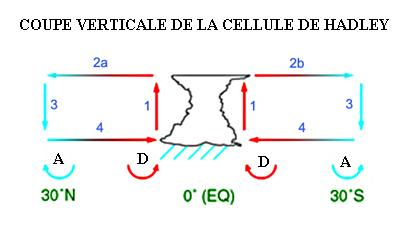South Atlantic High on:
[Wikipedia]
[Google]
[Amazon]
 South Atlantic High is a semipermanent pressure high centered at about 25°S, 15°W, in the
South Atlantic High is a semipermanent pressure high centered at about 25°S, 15°W, in the
 In the Horse latitudes, generally in the region between 30 and 35 degrees of north and south latitude, there are more or less permanent highs. This is the subsiding part of
In the Horse latitudes, generally in the region between 30 and 35 degrees of north and south latitude, there are more or less permanent highs. This is the subsiding part of
Atlantic Ocean
The Atlantic Ocean is the second-largest of the world's five oceans, with an area of about . It covers approximately 20% of Earth's surface and about 29% of its water surface area. It is known to separate the " Old World" of Africa, Europe ...
. It is also called the St. Helena High, Saint Helena island being the only land in the area. It can stretch thousands of miles across the South Atlantic. This does not mean that the position and the intensity of this anticyclone are permanent, but just that we find an anticyclone on the maps describing the average monthly pressure. This area of high pressure is part of the great subtropical belt of anticyclone
An anticyclone is a weather phenomenon defined as a large-scale circulation of winds around a central region of high atmospheric pressure, clockwise in the Northern Hemisphere and counterclockwise in the Southern Hemisphere as viewed from ...
s called the subtropical ridge
The horse latitudes are the latitudes about 30 degrees north and south of the Equator. They are characterized by sunny skies, calm winds, and very little precipitation. They are also known as subtropical ridges, or highs. It is a high-press ...
. The centre of the high pressure region tends to follow the seasonal variation in position of the sun
The position of the Sun in the sky is a function of both the time and the geographic location of observation on Earth's surface. As Earth orbits the Sun over the course of a year, the Sun appears to move with respect to the fixed stars on the ...
, moving south in the southern summer and north in the southern winter. This affects the climate of the adjacent continental areas, bringing seasonal changes to the climate and weather as the position of the high oscillates.
Formation
 In the Horse latitudes, generally in the region between 30 and 35 degrees of north and south latitude, there are more or less permanent highs. This is the subsiding part of
In the Horse latitudes, generally in the region between 30 and 35 degrees of north and south latitude, there are more or less permanent highs. This is the subsiding part of Hadley cell
The Hadley cell, named after George Hadley, is a global-scale tropical atmospheric circulation that features air rising near the equator, flowing poleward at a height of 10 to 15 kilometers above the earth's surface, descending in the subtropics ...
s. Indeed, near the equator, where the Coriolis force
In physics, the Coriolis force is an inertial or fictitious force that acts on objects in motion within a frame of reference that rotates with respect to an inertial frame. In a reference frame with clockwise rotation, the force acts to the ...
is quite weak, a direct circulation of air is established. In the lower levels of the atmosphere, the difference in temperature between the equator and the northerly warmer regions gives rise to the intertropical convergence zone
The Intertropical Convergence Zone (ITCZ ), known by sailors as the doldrums or the calms because of its monotonous windless weather, is the area where the northeast and the southeast trade winds converge. It encircles Earth near the thermal ...
where the warmer air rises because of convergence and relatively lower density. Subsequently, this air spreads north and south and cools at higher altitude and descends further north and south.
Associated weather
This system greatly affects sailing because the associated winds are generally not strong and sailing vessels have to go far north or south of the centre of the high pressure region depending on the direction of travel to find winds that are favourable in strength and direction.Climatic influence on economic
The anticyclonic circulation produces a dry climate, but its influence does not stop there: the South Atlantic High brings warm weather from the east coast of South America to Africa in summer as it carries tropical air to its southern flank. On its northern flank, where the winds are easterly trade winds, there is the intertropical convergence zone that controls theAfrican monsoon
A monsoon () is traditionally a seasonal reversing wind accompanied by corresponding changes in precipitation but is now used to describe seasonal changes in atmospheric circulation and precipitation associated with annual latitudinal oscil ...
and the rainy season in the Guianas
The Guianas, sometimes called by the Spanish loan-word ''Guayanas'' (''Las Guayanas''), is a region in north-eastern South America which includes the following three territories:
* French Guiana, an overseas department and region of France ...
.
References
External links
{{coord, 25, 00, S, 15, 00, W, source:kolossus-eswiki, display=title Anticyclones Atlantic Ocean Regional climate effects Climate of Argentina